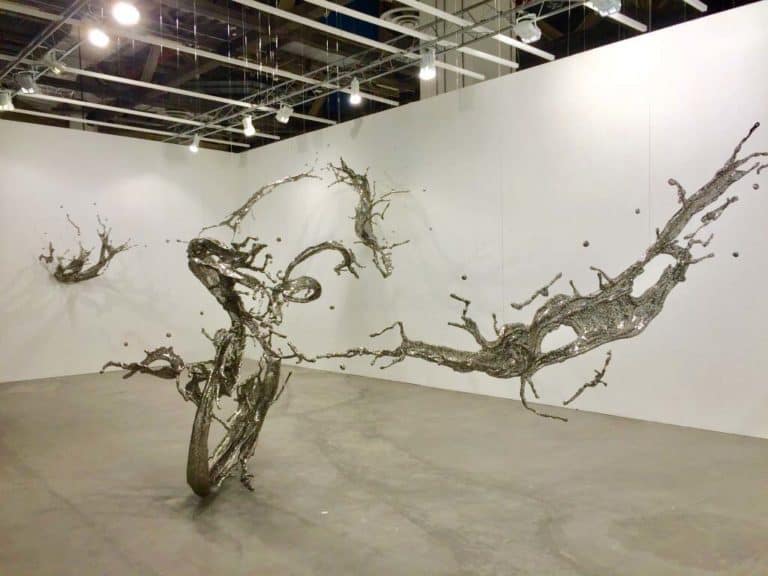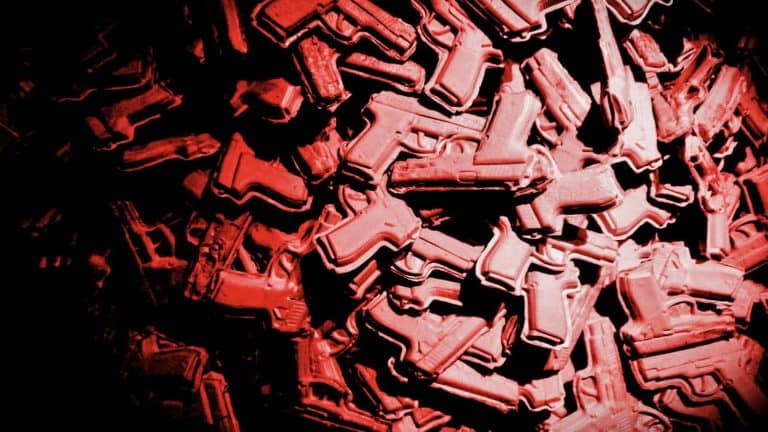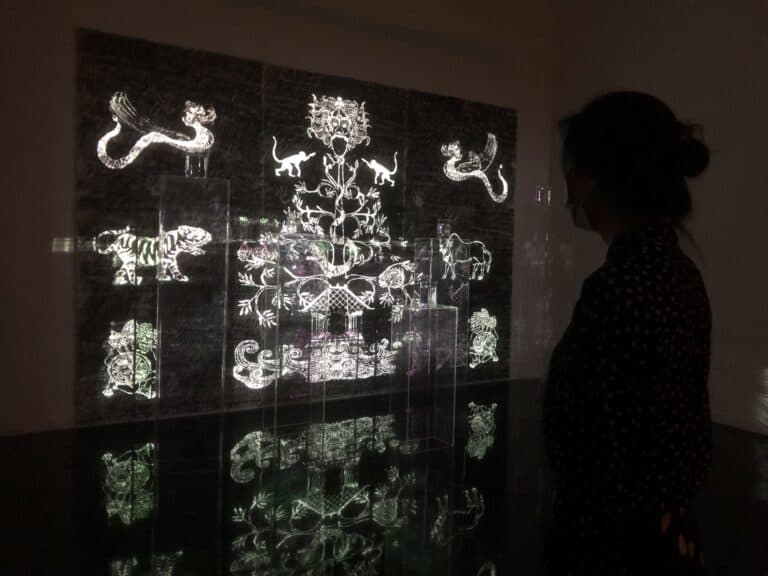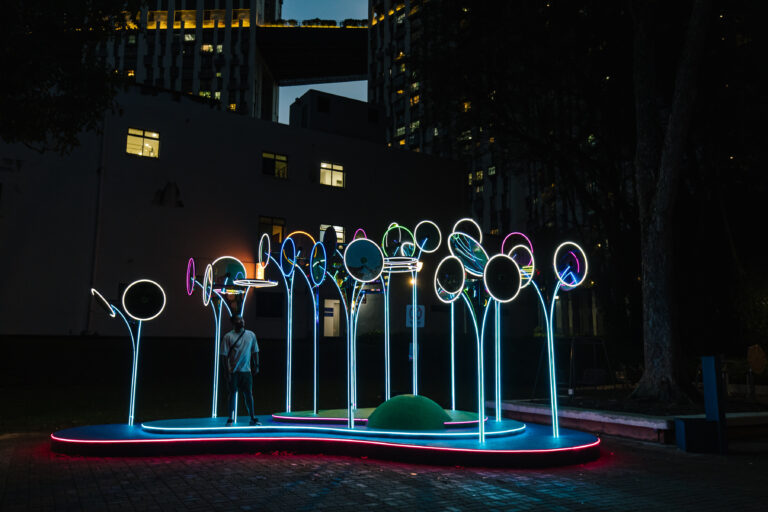There’s an art show on at DECK right now, that looks nothing like an art show.
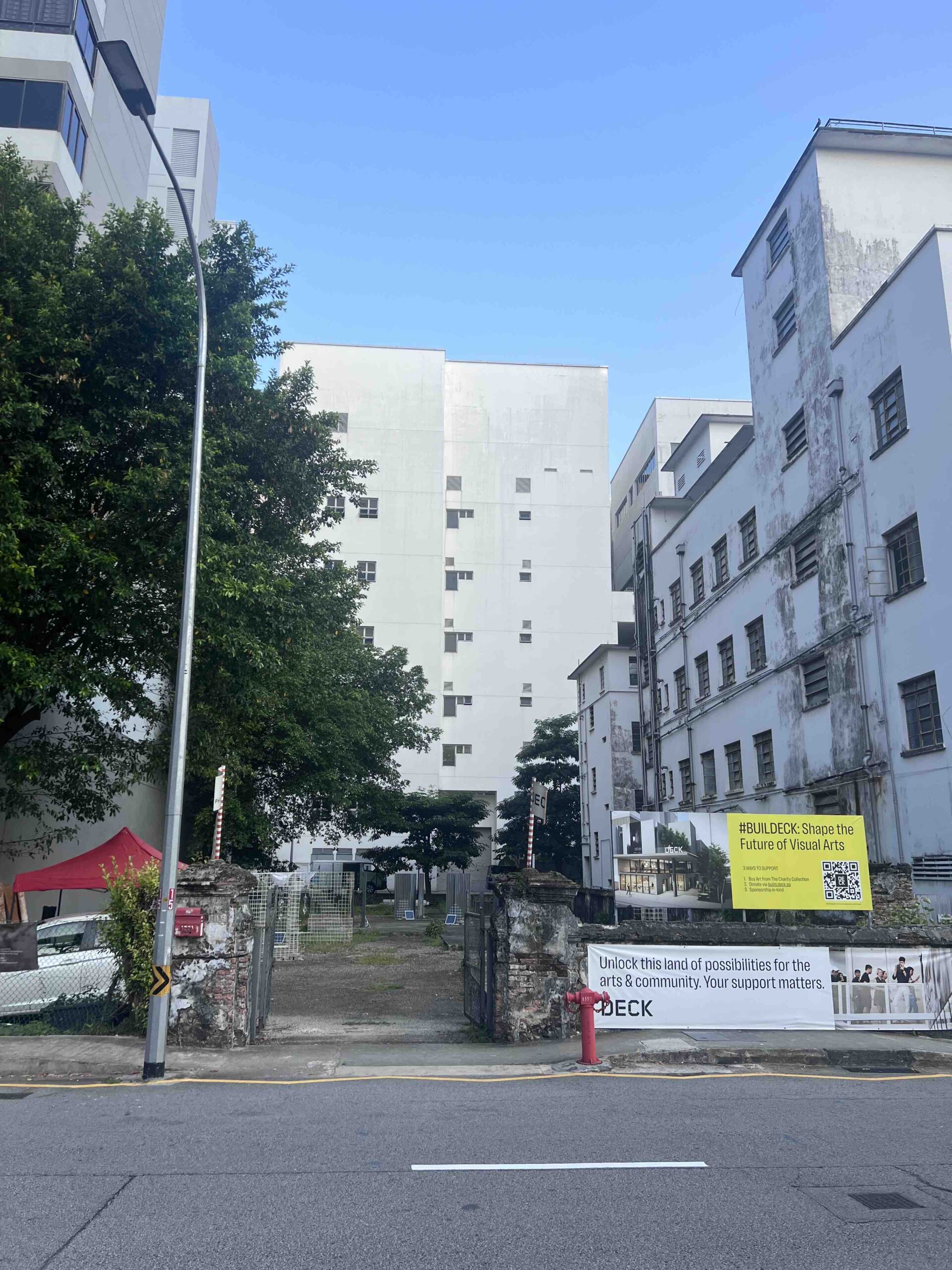
And yes, you read that right – it’s located at DECK, the art photography centre right by LASALLE College of the Arts, that’s no longer physically around. Previously composed of containers that were demolished in 2021 to make way for a new permanent building, what remains of DECK right now is nothing more than an empty field covered in grey rubble and the odd patch of green grass.
It’s upon this empty, barren space that Singapore artists Chok Si Xuan and Victoria Hertel, and curator Seet Yun Teng have chosen to locate their exhibition Sacrificial Protection. It’s an art exhibition that barely resembles one, with no wall text – or come to think of it – walls.
Entirely open-air, the show is broadly about how art can exist in tropical climates, and in so doing, what it can tell us about our human relationships with the environment. As the show organisers explain, “the exhibition is a product of an extended engagement between both artists, responding to each other’s practices as well as the environmental conditions of the site.”
Chok tells us:
“Seeing how both our practices have some form of electronics in them, we wanted to incorporate electronics into the outdoors in a way that could form some level of harmony, which returns to us thinking of tropical technologies. This was also a way to think about how materials react similarly to the weather, environment and tropical climate, which is similar to what we experience with our bodies, questioning the common perception of urban materials being inert.”
Steel structures in various states of corrosion and disrepair, dot the space and save for a small paper pamphlet with artwork details and an essay, there are no offerings of wall text or clear lines demarcating the artworks from the various debris onsite:
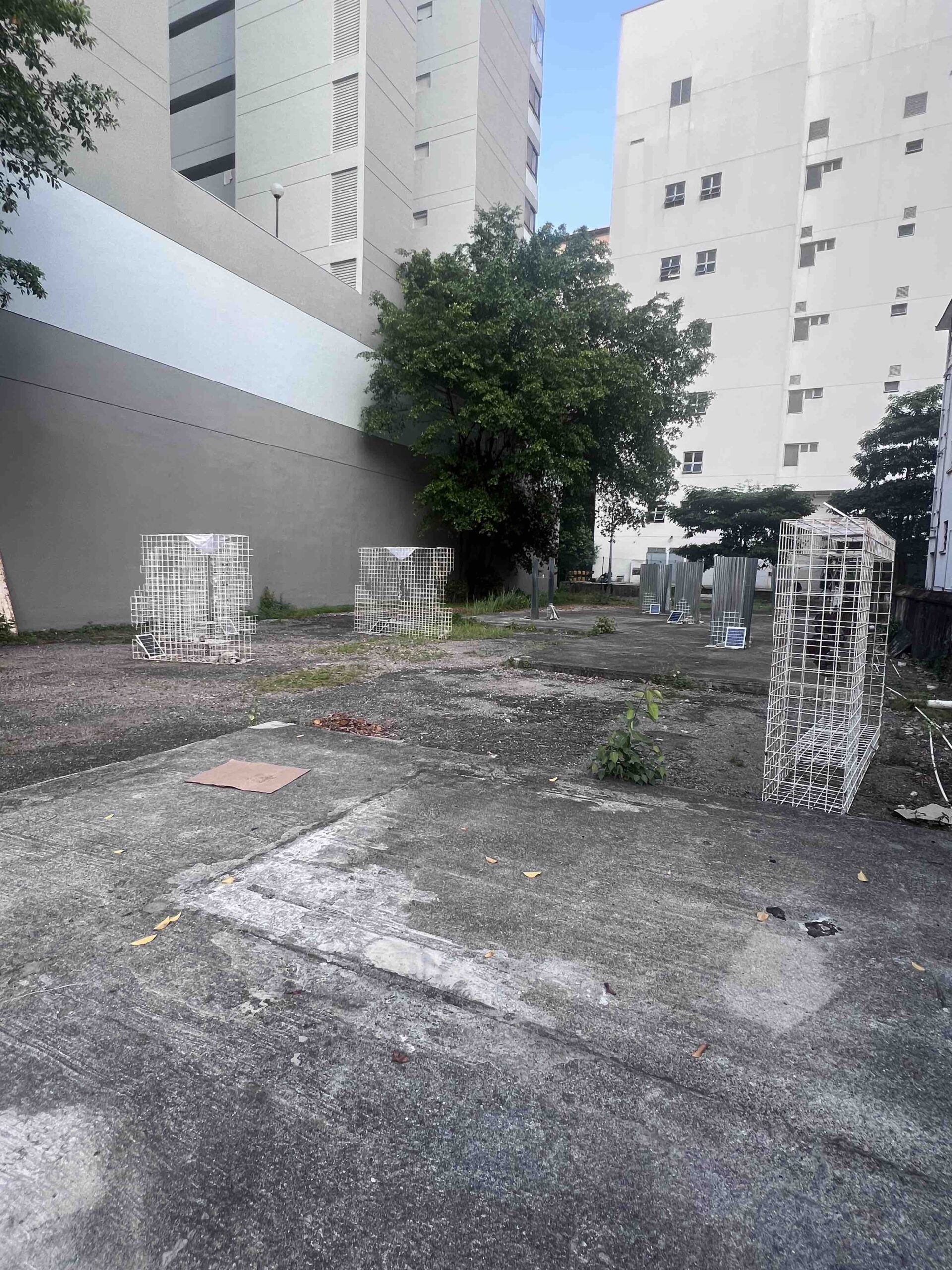
There are random pails, cupboards with cat food in them, cardboard boxes and all kinds of paraphernalia strewn around the space. (I’m told a gentleman comes by every evening to feed the community cats in the area).
It is almost a challenge to physically locate the artwork and sieve it out from the general detritus in the space.
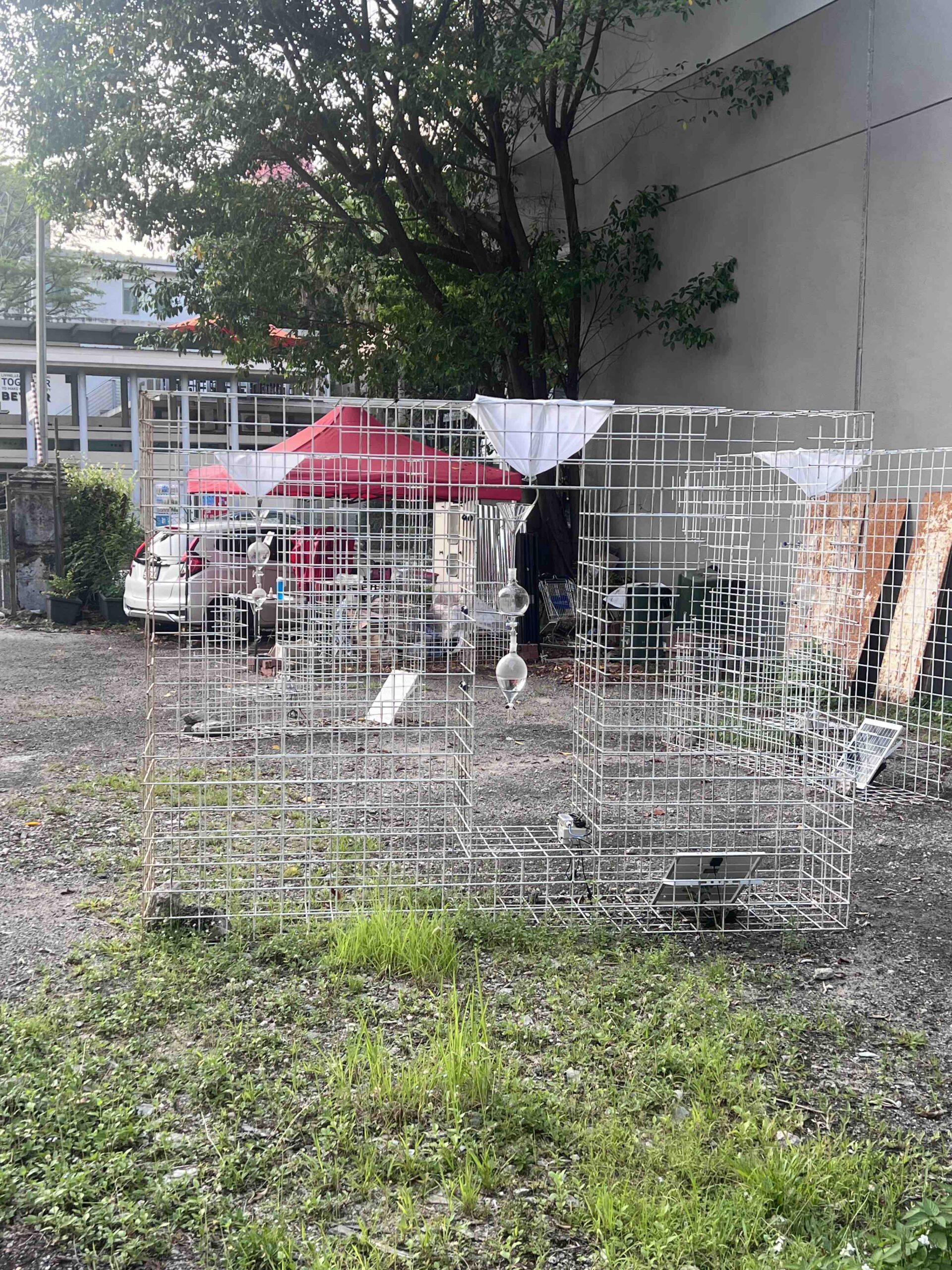
I am slightly nervous as I walk around the site, wondering if I’m going to look foolish if I ask the onsite ‘gallery sitter’ if I have correctly identified the artworks. The artworks themselves have no fancy titles, and are simply numbered from 1 through to 4, in clusters. As I walk around the space and take a closer look however, the works start to reveal themselves.
Exploring the kinetic sculptures
In these works, delicate glass funnels filled with collected rainwater are placed in metal frames (scavenged from the LASALLE Campus at Winstedt Road I’m told):
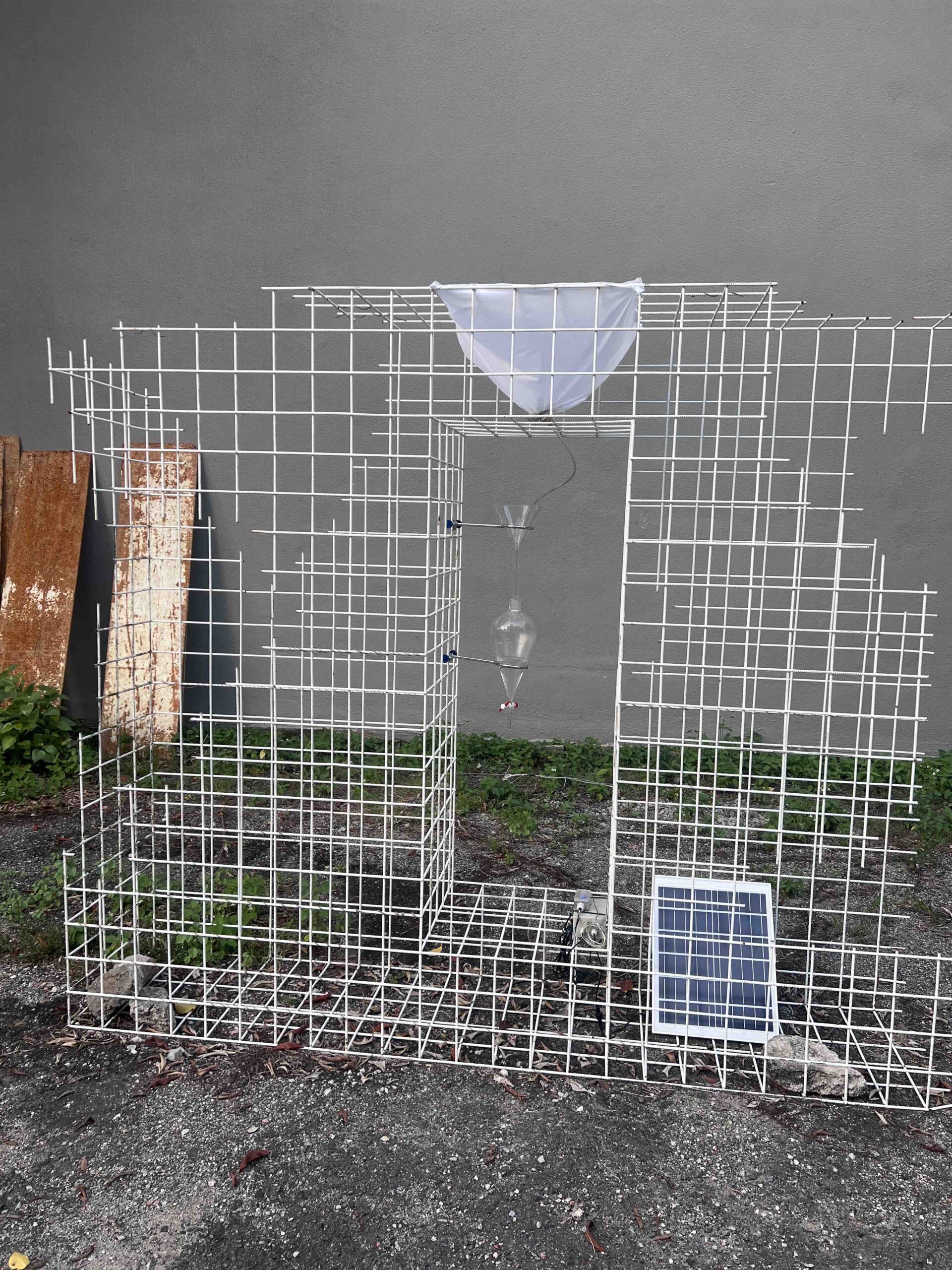
The funnels are intricately wired up to solar panels so that they eventually ‘spurt’ out delicate wisps of mist at certain intervals. Hertel explains that the funnels are discarded objects from a lab glass blowing company in Singapore which were unusable as lab equipment because of minor defects. However, they were “perfect” for the exhibition setup to guide rainwater onto atomisers, which then created a misting effect. In the spirit of environmental sustainability, this was also a way for the artists to use pre-existing materials as opposed to acquiring new ones.
The work offers a subtle nod to the heavy humidity of the tropical environment in Singapore. The sharp edges of the rusting and broken frames offer a dramatic contrast to the fine curls of mist that emerge from the funnels, which make me think that the frame could either be freezing cold, or smoking with heat.
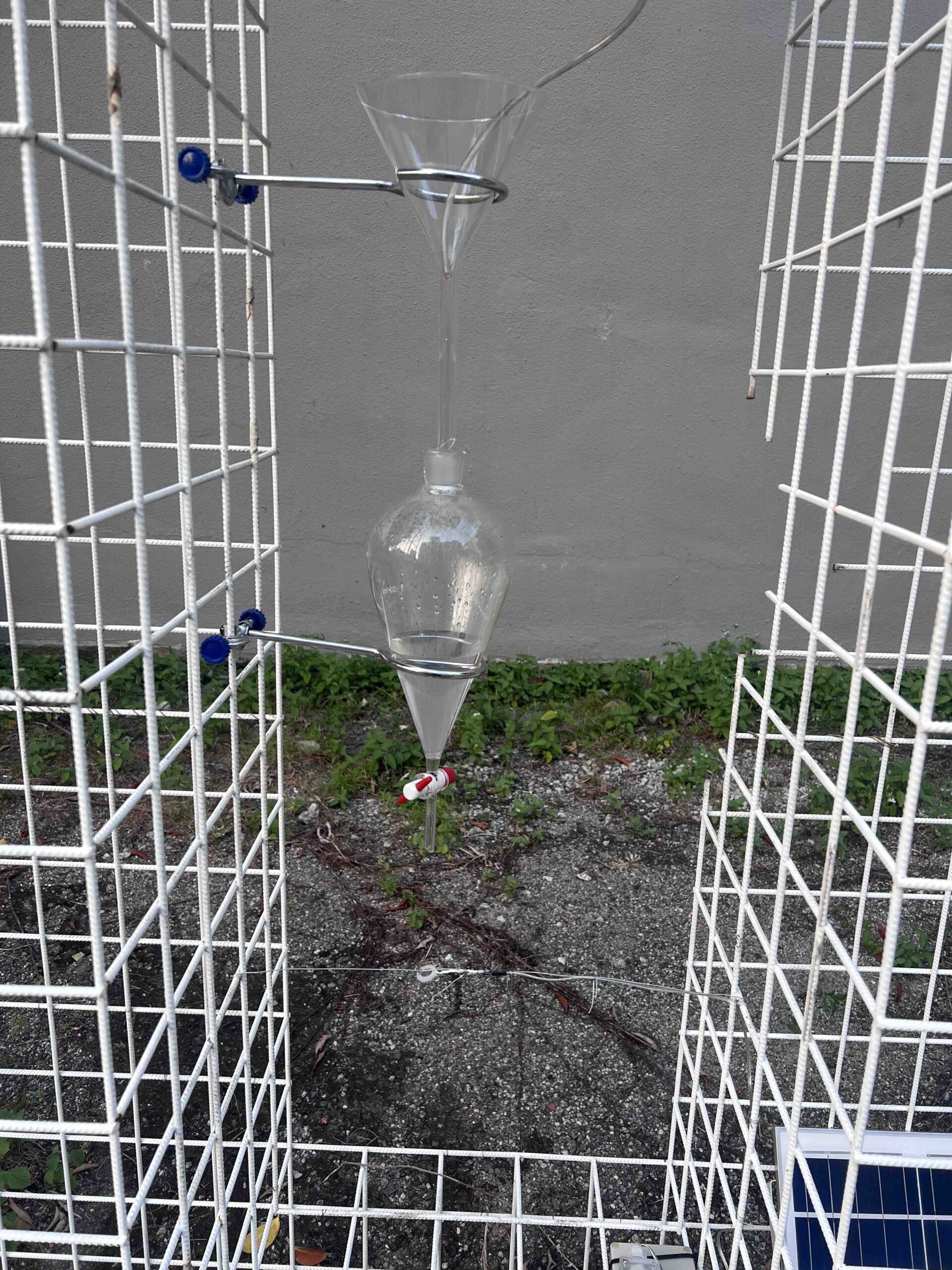
There is a sharp duality to this work that brings to mind all the complications of environmental harm and climate change. In her catalogue essay, Seet references Martin Mahony and Georgina Endfield’s paper Climate and Colonialism which argues that imperial discourses have “effectively normalised the environmental characteristics of other places against the measured standard of the temperate zone.”
Says Seet in her essay, “it’s no surprise today that infrastructure is designed and constructed in ways that shut out tropical weather and create climates that are colder and drier,” something that Mahony and Endfield describe as a “unique blend of comfort and central control, where people have mastered their environment, but at the cost of individual autonomy, and at the risk of unsustainability.” There are echoes here of the air-conditioned nation and all its controversial attendant considerations.
Behind these frames, clanging and whirring sounds emerge and I am not sure if they are coming from the people loitering with cigarettes in the backlane behind the show, or from the artworks, or from something else altogether. Thankfully, someone is on hand to explain that in this series of works, solar panels activate motors that work to strike objects against corrugated zinc-coated steel sheets. These then generate sounds which resemble the patter of rain on rooftops.
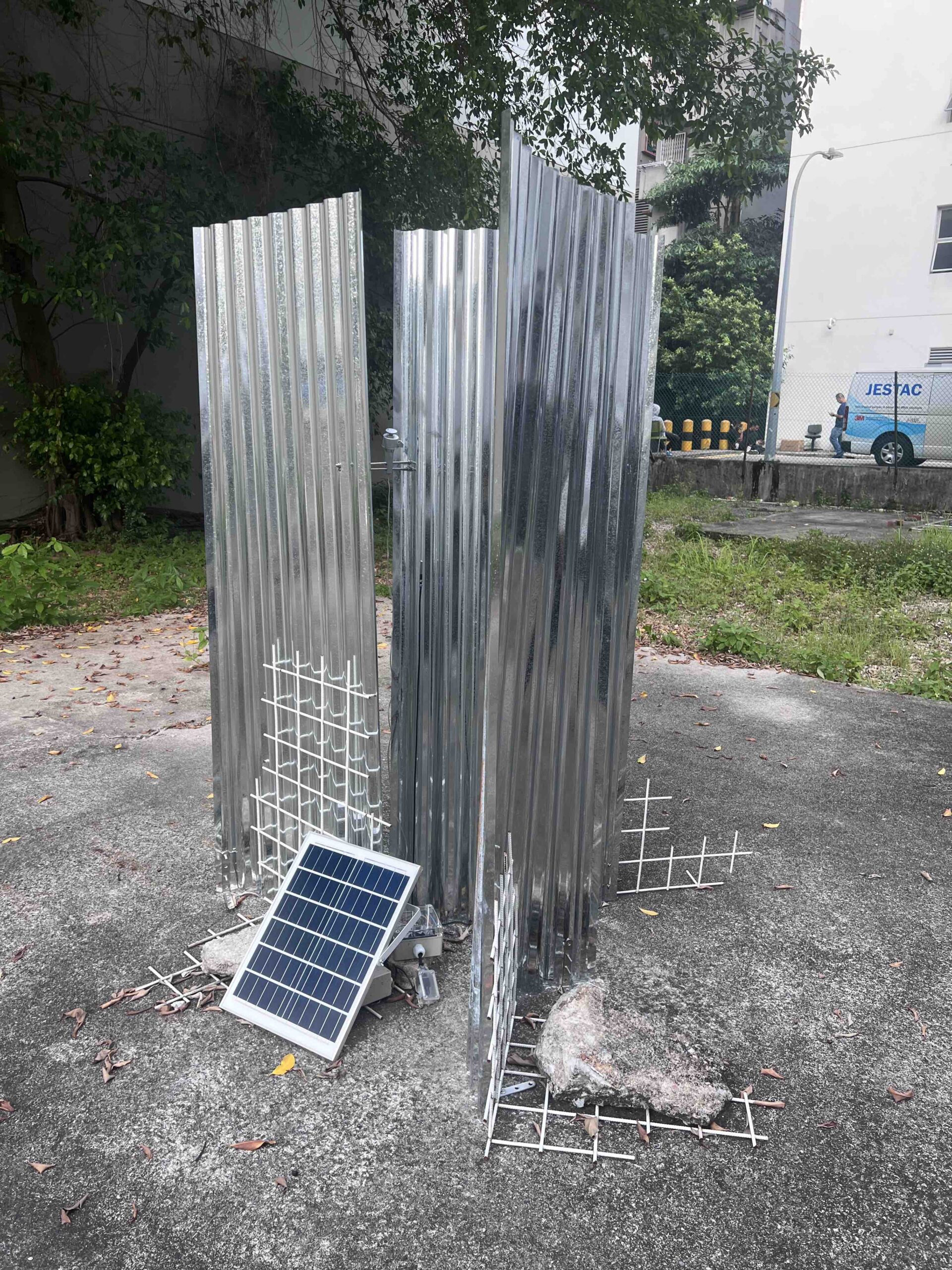
The movements and sounds triggered in these contraptions will change depending on the levels of sunlight in the space, and will turn on and off spontaneously. The sounds initially provide a reassuring kind of background noise as one slips in and out of the sculptures and installations, but discordant shifts in the experience start to take place when one kinetic sculpture stops moving randomly and another starts up. The unpredictability of the auditory experience is jarring, adding another layer of discomfort to the already – hot and sweaty outdoor viewing experience.
Chok explains that while the wires on display in the show appear to be exposed, they are actually all very carefully insulated to protect them from the elements. She tells us that this is the second time she’s teamed up with Hertel to showcase artworks outdoors (the first time being at 2022’s Night Festival).
The title of the exhibition refers to the concept of “sacrificial protection” which is a corrosion protection method where a more active metal prevents a primary metal from rusting. One common example of this is galvanised steel, which is coated with a layer of zinc which then oxidises while ‘protecting’ the underlying metal. The most apparent physical manifestation of this concept can be seen in this rust-filled work (being adjusted by the gallery sitter):

There’s also a “secret” work if you can spot it, a little glass vessel (this one hand-blown by Hertel) that hangs sweetly in a little brick hole, framed by a profusion of plants.
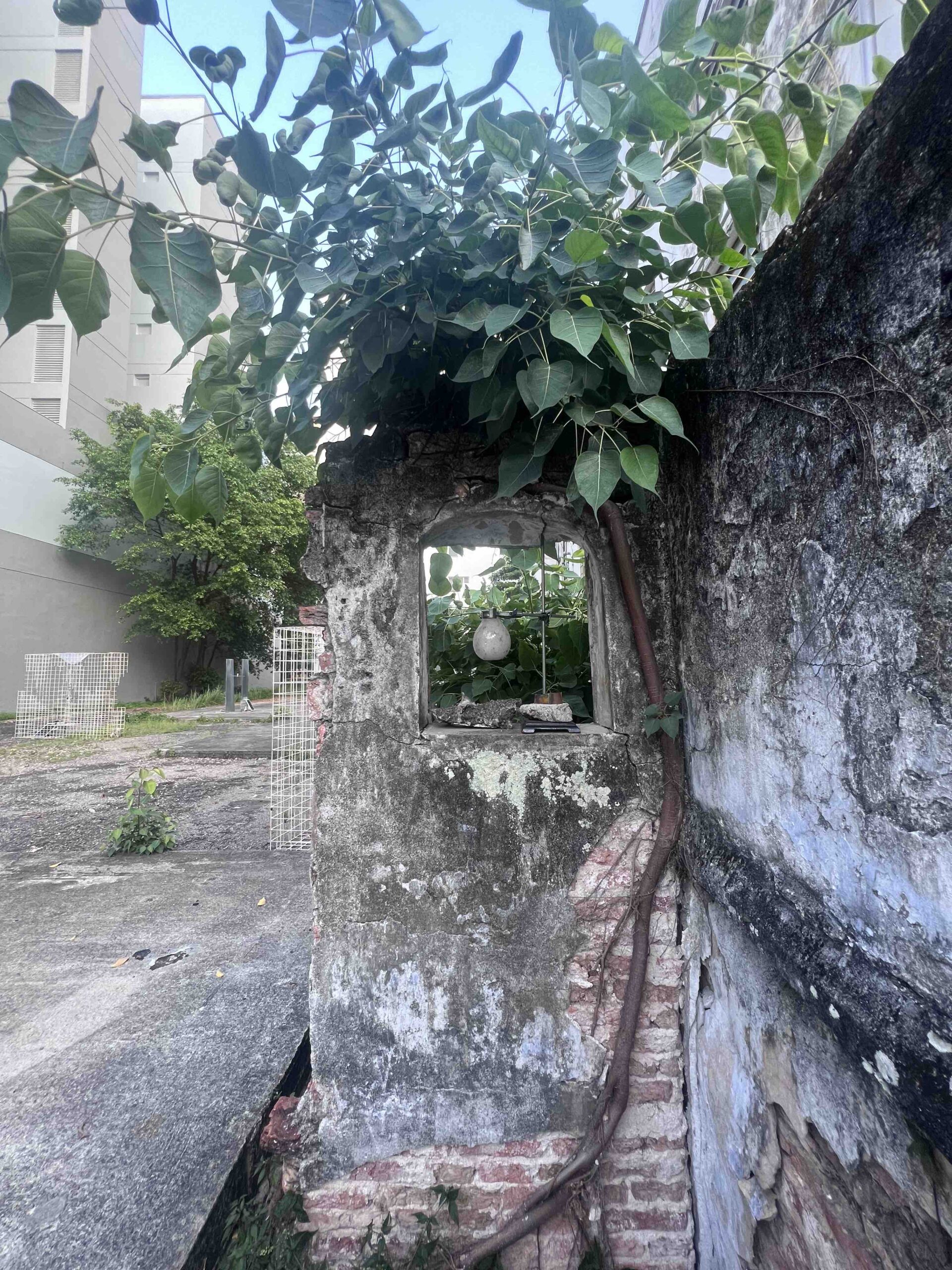
It’s made from crushed solar panel glass which Hertel explains is actually “incredibly tough to recycle from a material perspective because the glass, plastic, metal and solar cell components become so fused and crushed that extracting the debris to make each element reusable is very challenging.”
Still, she and her mentor embarked on this arduous task and she tells us that the fumes released from the debris through the hot glass transformation process were quite toxic, causing the two to “cough quite a bit while working the glass.”
The altar-like setting of this work is clever, communicating the grave importance of sustainable art practices while also highlighting the “darker nuances of material life spans.” The very solar panels which power the exhibition have themselves only a life span of about 25 years. Coupled with the difficulties of recycling the panels, viewers are invited to re-consider their perceptions of what sustainable art practices can and should look like.
Artistic and environmental collaborations
Seet, Hertel and Chok have also done a good job in syncing the aesthetics of the site with the actual artworks.
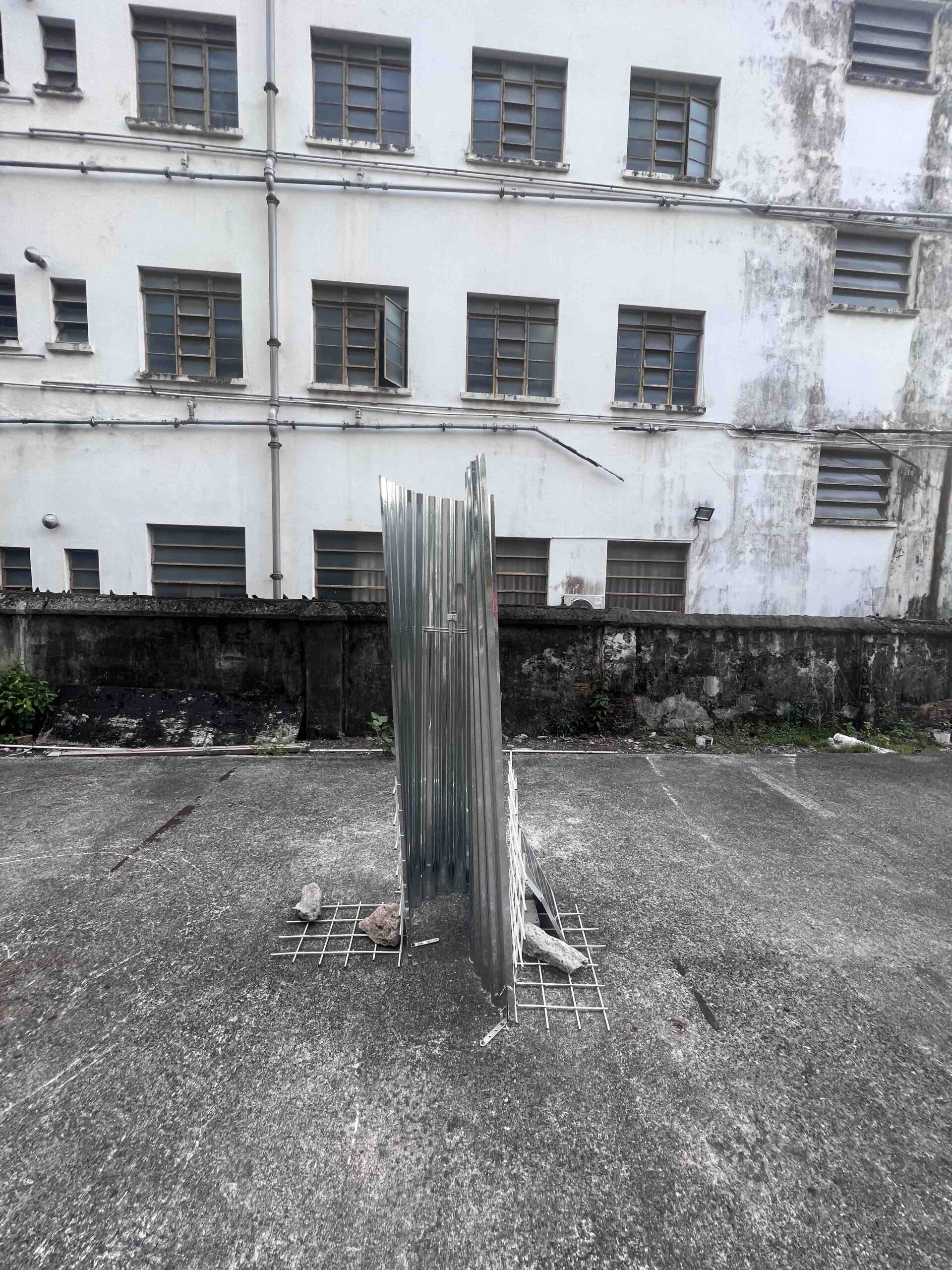
While shooting the photographs for this review, I found myself thinking that the old weather-worn buildings adjacent to the DECK space looked as though they had been purpose built to frame the artworks on display. I also particularly enjoy the fact that that ephemeral environmental factors such as “sunlight” and “time” are formally credited in the descriptions of the artworks, as part of their mediums of composition.
It is interesting that there are no individual artist attributions to the works. Seet tells us that all works were made collaboratively without one artist’s authorship over another and that “it’s hard to tell where one artist’s agency begins and ends in the work.”
“During the tours,” she continues, “people who came in with an understanding of [the artists’] practices were trying to guess who made which part (and often the truth was the opposite).”
Seet reflects that the aspect of collaboration was both the hardest and best bit of the show. Seeing herself as an “interlocutor” in the collaboration, Seet feels that the works are not completed art pieces in themselves, but instead “experimental test pieces” with many materials and processes being brand new mediums for both Hertel and Chok.
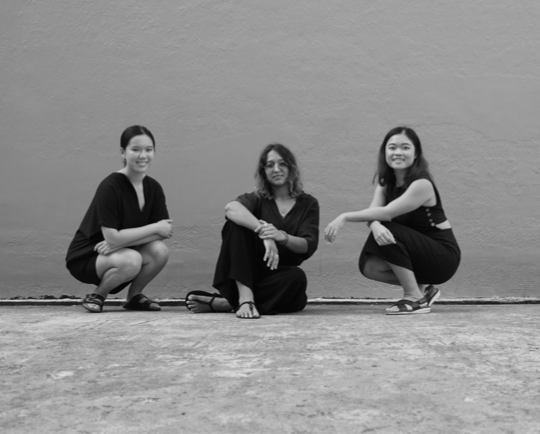
Sacrificial Protection is that rare thing in the local art world – a dramatic display, unusual enough to prompt a freewheeling wander into the exhibition space, but with enough guidance to make the average viewer feel educated about what they are looking at. It’s not a conventionally beautiful art showcase, but perhaps offers something better. There are many thoughtful points of interaction here, and opportunities to reflect on the role of art in highlighting environmental concerns. The show runs till the end of 20 October, so catch it soon before it closes.
__________________________________
Find out more about DECK and Sacrificial Protection here






